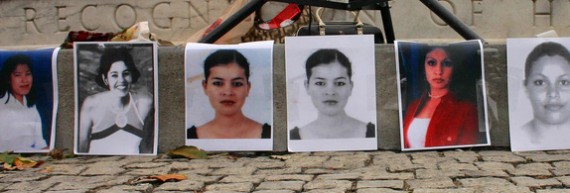In the sister cities of Ciudad Juarez and El Paso, Mother’s Day 2013 had a prolonged calendar life because of cross-border family ties, work schedules and commercial promotions. An international fusion made for a long weekend of parties, sales events and musical tributes extending from the days immediately leading up to the Mexican holiday of May 10 to the U.S. celebration on May 12.
Perla Reyes and Carmen Castillo were two mothers who weren’t celebrating, though.
The Ciudad Juarez women joined other moms from the new organization Madres y Familias Unidas por Nuestras Hijas (Mothers and Families United for our Daugthers) and their supporters in plastering downtown Ciudad Juarez with more than 1,500 posters of disappeared or murdered young women, including Monica Liliana Delgado Castillo, found dead in the Juarez Valley in early 2011, and Jocelyn Calderon Reyes, missing since late last year.
Relatives of the missing suspect their loved ones have fallen prey to human traffickers.
“Many people have things to celebrate in their homes, but there are mothers in this city who have nothing to celebrate,” Imelda Marrufo, coordinator of the Women’s Roundtable of Ciudad Juarez, said as she took a break from the postering.
Marrufo and fellow activists fanned out into the bustling blocks surrounding the downtown Cathedral and the dusty redevelopment project enveloping the zone.
Soon, passerby saw the photos of Janeth Paola Soto Betancourth, Cinthia Jocabeth Castaneda Alvarado, Diana Rocio Ramirez Hernandez, Maria Guadalupe Perez Montes, Jocelyn Calderon Reyes, Maria de la Luz Hernandez Cardona, Idali Juache Laguna, Griselda Murua Lopez, Silvia Arce, and Monica Janeth Alanis Esparza. The poster of a smiling Monica Liliana Delgado, the only one in the particular group whose fate has been officially determined, read: “A Warrior Never Dies.”
Except for 29-year-old Silvia Arce who disappeared back in 1998, all the individuals on the posters vanished from 2008 to 2012, when they were between 13 to 19 years of age. All went missing during the Great Violence, a time when the city was crawling with soldiers, federal police and assorted gunmen. Ironically, many of the missing were born during the years when the disappearance and killing of women in Ciudad Juarez first became an international issue.
Ricardo Alanis, father of university student Monica Janeth Alanis, who was 18 when she disappeared in March 2009, said there were “no leads, no indications” of what might have transpired with his daughter. Last month, Alanis and his wife Olga Esparza were honored by El Paso’s Annunciation House for their persistent activism. Alanis insisted that a lack of “political interest” prevails in clarifying the fates of his daughter and other disappeared persons.
Quoted on Mother’s Day by the state prosecutor’s office, Chihuahua State Human Rights Commission President Jose Luis Armendariz said the top state law enforcement agency was making advances in investigating women’s disappearances by means of a new investigatory protocol. “We recognize there are problems,” Armendariz said, “but let’s all participate more so (disappearances) don’t occur.”
Marrufo credited the current administration of the prosecutor’s office for showing improvements over its predecessors on the gender justice front, but faulted the state agency for coming up short in the “high-risk” disappearances like the ones publicized by Mothers and Families United. She said the state should have specialized units to probe the unresolved cases. “We think the prosecutor’s office should have better trained teams,” Marrufo added.
The posters displayed by Mothers and Families United represent only a small fraction of disappeared girls and women in Ciudad Juarez. While the group covered walls, street lamp posts and telephone boots with pictures of relatives, another group of mothers of the missing and their supporters initiated a 24-hour vigil outside the border offices of the Chihuahua state prosecutor’s office.
Marrufo said her organization knew of 190 women and girls missing in the city since the late 1990s, but acknowledged the number could be short since disappearances began mounting after 1993 if not sooner.
Age, appearance, family and social background, and the location of disappearance form striking parallels between the post-2008 disappeared and their counterparts from earlier years. Many were last reportedly in the city’s downtown core.
Teenager Jocelyn Calderon went missing in the middle of the afternoon on December 30, 2012, while she was presumably headed to the Cathedral to meet a friend. Mother Perla Reyes said the young girl had since been reported seen in different parts of the city, but the information could not be confirmed by relatives.
“We don’t know if it’s true or not,” Reyes told FNS. “My kids are afraid. They cry a lot. My mother is sick. These are hard blows which have affected the entire family.” The Ciudad Juarez resident appealed for help from U.S. neighbors in solving women’s disappearances.
The story of Monica Guillen Delgado Castillo is hauntingly similar to other young female murder victims from ten years ago or more. Both Monica and her mom Carmen Castillo were newcomers to Ciudad Juarez, drawn to the border city from their native state of Durango by a lack of money and the need for work.
Fresh out of high school but unable to pay for college, Monica Delgado had spent only four months in the city when she vanished on October 18, 2010, while presumably catching a downtown bus. According to mom, Monica had a boyfriend but otherwise maintained a very limited social life and spent a lot of time at home.
For a spell, Monica worked on the downtown streets recruiting students for a private English and computer school. According to Castillo, the authorities claimed they later recovered Monica’s body from the rural Juarez Valley about 35 miles from the city on January 20, 2011. Yet the 17-year-old was not immediately identified and instead interred in a common grave.
After months of pressing state authorities about her daughter’s whereabouts, Castillo said officials finally informed her in September 2011 that Monica had been found dead months earlier.
“I don’t believe in the state prosecutor’s office now. They don’t do things right,” Castillo said. “I only believe in divine justice.”
The background to Monica Delgado’s disappearance and reported murder is déjà vu from years ago. The Durango transplant worked for a private school with a business model akin to the old ECCO computer school, where numerous femicide victims from both Chihuahua City and Ciudad Juarez studied or worked between 2000 and 2003.
The slayings of the ECCO-linked victims were followed by glaring investigatory irregularities, the official concealment of bodies, the mistaken identification of corpses, and the fabrication of scapegoats.
Female murder victims with some sort of connection to ECCO were typically disappeared for weeks or months before being found in clusters of multiple homicide victims in and around Ciudad Juarez and Chihuahua City. More recently, the multiple remains of girls and young women who vanished from Ciudad Juarez, especially the downtown area, were found in the Juarez Valley. Like the contemporary Juarez Valley cases, the murders from more than a decade ago linger in impunity.
Carmen Castillo said she did not know of the common school background of previous victims until after Monica’s disappearance.
Together with other local and national groups, Mothers and Families United and the Ciudad Juarez Women’s Roundtable demand decisive governmental actions to prevent disappearances from happening in the first place; adequate investigations of pending cases; and greater federal involvement in the issue, among other measures.
The Ciudad Juarez Mother’s Day action was part of a national effort held in coordination with women’s and human rights organizations active in Chihuahua City, Guadalajara, Culiacan and Tecate.
The civil society groups laid out common goals of educating the public about gender violence, re-publicizing the issue of disappeared women and femicide in Ciudad Juarez, and pressuring the authorities to address similar situations across the Mexican republic. A statement issued by the participating organizations declared the campaign will reach 18 nations in Latin America, Africa, Asia, and North America.
Although Ciudad Juarez became notorious decades ago for murdered and missing young women, information distributed by Mothers and Families United and allied groups documented how the issue is a national one. For example, a bulletin issued by the new justice campaign reported 1,184 cases of missing women in the state of Jalisco, home to Guadalajara, Mexico’s second largest city.
Contrary to the national pattern in which men are the clear majority at 60 percent of the nearly 26,000 cases of disappeared people listed on the National Registry System of Missing or Disappeared Persons, the authors noted that women represent 53 percent of all disappeared cases in Jalisco.
“Undoubtedly, this is one more indication of gender violence in the state of Jalisco,” the bulletin contended.
In their bulletin, the campaign’s members recalled that Mexico is under an obligatory sentence from the Costa Rica-based Inter-American Court of Human Rights to prevent, investigate and sanction violence against women.
“This is the first simultaneous action of different actions at the same time,” Marrufo said of the renewed justice campaign in Ciudad Juarez and other Mexican cities. “Every mother and father wants to know what happened to their daughters and have them back at home. This is urgent.”
(Creative Commons feature image via Flickr by Elvert Barnes)




Responses to “Juarez Mothers Renew International Campaign”